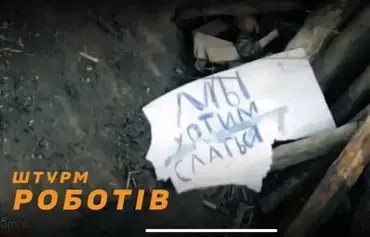Security
Ukrainian ground drones force Russian troops to surrender in historic first
A Ukrainian assault unit used unmanned ground robots to capture enemy positions and take prisoners without a single infantryman on site.

By Galina Korol |
A ground robot rolled toward a Russian dugout. Moments later, enemy troops held up a cardboard sign: "We want to surrender."
Russian soldiers recently gave themselves up to an unmanned system operated by Ukraine's 3rd Separate Assault Brigade. The unit says this is the first confirmed case in modern warfare where troops surrendered and positions fell without any direct involvement from infantry.
The incident, documented in a video posted July 9 on the official Facebook page, took place in Kharkiv province. Ukrainian forces had previously failed to take the fortified position but succeeded this time using a combination of first-person-view (FPV) drones and kamikaze unmanned ground vehicles (UGVs).
As one of the robots approached a half-destroyed dugout, Russian soldiers inside signaled their surrender using a makeshift sign.
![A Ukrainian drone operator with the call sign 'Director' is shown during a combat mission July 12 at an undisclosed location along the Russian-Ukrainian front. [Director personal archive]](/gc6/images/2025/07/21/51216-robotattack_1-370_237.webp)
"They [the Russian troops] saw the UGV, and somehow, really quickly, found a piece of cardboard -- I have no idea where they got it -- and even something to write with. And they threw up that sign almost immediately," recalled one of the 3rd Separate Assault Brigade fighters.
Ukrainian troops accepted the surrender. Two Russians emerged and were guided to safety by hovering Mavic FPV drones nicknamed "birds" by the unit.
"Using a drone, we indicated to them that they should follow us... and basically they understood everything. They got [to the Ukrainian positions] quite neatly thanks to the Mavic," a fighter in the video said.
The brigade secured enemy fortifications and nearby forest without a single human casualty. The goal is simple: keep men out of the line of fire, say soldiers.
"The main motivation is for our infantry to stay alive," one of the Ukrainians explained.
The future of robotic warfare
Such operations mark a new chapter in modern warfare, say analysts.
Few could have predicted the success of Ukraine's drone capabilities, said Andriy Kharchuk, a military historian and professor at Hetman Petro Sahaidachnyi National Ground Forces Academy.
"If someone had told me four years ago about the kind of success our aerial and maritime drones would achieve, I simply wouldn't have believed it was possible. And now it's the ground drones' turn," he told Kontur.
"First of all, they allow us to protect our most precious resource -- the lives of warriors."
Kharchuk pointed to the cost efficiency of robotic assaults, calling them a grim but practical investment.
"Such attacks pay off because -- cynical as it may sound -- a human life, in monetary terms, is worth much more," he said.
Still, he warned that robots cannot fully replace infantry on the battlefield.
Serhii Grabsky, a military analyst and retired colonel who served in Kosovo and Iraq, agreed.
"It's necessary to pursue this line of effort. Anything that helps minimize our losses is worthwhile," he told Kontur.
Changed thinking
Drones have reshaped both battlefield tactics and thinking, the commander of a Ukrainian platoon specializing in unmanned systems told Kontur.
"Drones, on their own, change nothing. It's the thinking about how to use them that does," said the commander, using the call sign Director.
The machines still depend on human operators, he said. Ground robots, he said, have been in use for about two years to deliver ammunition, evacuate the wounded, clear mines and carry communication repeaters.
Their effectiveness comes from how well operators combine different systems to meet mission needs.
"In essence, you have to understand what your available assets allow you to do -- and under what circumstances," Director said.
He highlighted hybrid operations that pair UAVs with UGVs, allowing forces to strike without putting personnel at risk.
"There's no need for someone to go somewhere physically," he noted.
Carrier drones can transport FPV drones far beyond their normal range -- up to 100km-- enabling pinpoint strikes, including targets "right through a window" at 50 to 70km, Director explained. Until recently, such capabilities seemed like science fiction.
"Any use of technology always helps minimize human losses," he said. "Building a drone is difficult but possible. Regrowing a leg, arm or head or bringing someone back to life is not."
The way to victory
The 3rd Separate Assault Brigade's operation shows that robot-led assaults can not only succeed but result in enemy surrenders, an emerging milestone in modern warfare.
Ukraine, positioned at the forefront of battlefield innovation, is shaping new military standards through real-time experience.
Constant technological development is essential in war, said Director.
"Without technology, we won't win this war through sheer numbers. That's already clear, and it's our only path forward," he said.